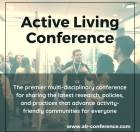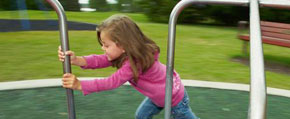We are pleased to announce an exciting new alliance between Active Living Research and GP RED to co-host and coordinate...
From Good Ideas to Actions: Model Driven Community Collaborative to Prevent Childhood Obesity
Presentation at the 2009 Active Living Research Annual Conference
Background:
Children’s overweight and obesity status has risen steadily across gender, income level, ethnicity and age. And, while obesity rates have increased for boys and girls within each ethnic and racial group, they have increased more for African American, Native American and Mexican American children. The state of Nebraska statistics mirror national averages with one in every six Nebraska elementary students (grades K-12) (16.2%) being overweight, and one in every three (33%) are at risk for becoming overweight or are overweight. In Nebraska, Native American and Latino students are more likely than students of any other race/ethnicity to be overweight. At the same time, African American students are 20.5 percent more likely than Caucasian students to be overweight. Nebraska is the 20th heaviest state in the nation with disparities among various racial and ethnic groups especially alarming.
According to the Institute of Medicines 2007 report, “Progress in Preventing Childhood Obesity: How do we measure up?” the best chance of success in addressing childhood obesity is if public, private, and voluntary organizations combine efforts, share resources, and create coordinated and sustained efforts.
Objectives:
The purpose of this presentation is to discuss the first year of a collaborative partnership effort in Nebraska to prevent and treat childhood obesity including: how the collaborative began, the use of models to guide the collaborative, and finally the strategic business plan that is the result of the first year and sets the stage for the second year of the collaborative.
Methods:
Our Healthy Community Partnership, (a catalyst 501C3 organization that brings together 32 organizations around community health) and Alegent Health, (a not for profit integrated
health care delivery system), joined forces in the fall of 2006 to facilitate community dialogue about how to significantly change the course of childhood obesity in Omaha, NE. The community initiative brought together key stakeholders from healthcare, government, service providers, and business and community leaders due to a common interest of creating a community coalition to oversee a long-term sustainable approach to preventing obesity. At the end of the process, an executive committee and seven strategic planks were identified including: physical activity (PA), nutrition, physical environment, social marketing, fundraising, evaluation, and leadership.
The models used to guide the community effort included the Ecological Model, Health Policy Model, and the 5 “P” Model.
Results:
The executive committee and the planks developed a vision and initial work plan for a community initiative called Activate Omaha Kids, a name that tied into the established recognition of Activate Omaha. Activate Omaha was an Active Living by Design grant, funded in 2003, to increase PA levels and enhance the environment of Omaha to support PA through four strategies including: a three year social marketing campaign, a citizen’s manual, bicycle advocacy through the bicycle commuter challenge, production of the bicycle and pedestrian map, and safe routes to school. The aim with Activate Omaha Kids was to broaden the support base and energy already harnessed by Activate Omaha.
In January of 2007, a public forum was held and citizens were invited to join plank activities. A total of 149 community stakeholders volunteered for the planks. Each plank developed specific strategies and timelines to achieve the Activate Omaha Kids mission using best practices and the most feasible approaches for Omaha, NE. From March 2007 to December 2007 monthly meetings of both the executive and plank committees occurred. Over 200 community volunteers and more than 90 organizations have participated in the various plank activities to date. Strategic plans were finalized in January/February 2008 using the 5P model. The 5P model assisted in assessing gaps and redundancies of the plan and its relationship to the ecological model. Some planks were heavily engaged in preparation activities based on the limited resources and pervious effort in the community, while other planks focused on needed programming. By categorizing the proposed activities with the 5 P model, the committees identified the relationships between similar activities across planks, integrated those activities, and developed a comprehensive time table of activities to the greater community.
Conclusions:
During the second half of 2008, Activate Omaha Kids will move to the next two priorities of the coalition - implementation and evaluation. Over one million dollars has already been secured to ensure implementation of the 24 initiatives, 7 of which already have evaluation plans written. Additionally, just under a half million dollars of other funding requests are in review. Suggestions for other communities working to build collaboratives such as Activate Omaha Kids include: 1) hire dedicated staff, 2) evaluation should be considered first and foremost, and 3) the interest of the coalition should have higher priority than a personal agenda. The future will be pivotal towards building a sustainable coalition that achieves measurable improvements in the health of the children in Omaha and our surrounding communities.
STAY UP TO DATE
RECENTLY ADDED TOOLS & RESOURCES
MOVE! A BLOG ABOUT ACTIVE LIVING
The "Active Living Conference" aims to break down research and practice silos and...







